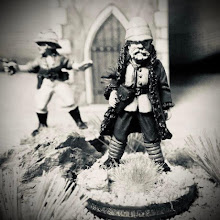First of all, let's get all of the disclaimers out of the way:
1. I know the British Indian Army did not have shorts during the period of the Anglo-Russian War (or did they?).
2. I wanted a British unit with Wolseley helmets for The Men Who Would be Kings! Wolseley helmets are cool.
3. The Lewis machine gun is a filler for the issue I discussed earlier with Copplestone packaging in their Back of Beyond range. The Lewis will be used in other campaigns to come.
4. I'm playing with Toy Soldiers. Now that it's all cleared up, on with the show! (BWAH HAH HAH!)
One of the oldest Regiments in the British Army, it was formed as a fusilier regiment in 1685 by George Legge, 1st Baron Dartmouth, from two companies of the Tower of London guard, and was originally called the Ordnance Regiment. Most regiments were equipped with matchlock muskets at the time, but the Ordnance Regiment were armed with flintlock fusils. This was because their task was to be an escort for the artillery, for which matchlocks would have carried the risk of igniting the open-topped barrels of gunpowder.
In 1865 it was at Ferozepore. It returned to Britain from India on the 27 December, 1870. It embarked for Gibraltar in 1885, and in 1886 and 1887 was at Egypt. From 1888 'til 1901, it was posted to various locations in India, including Poona, Karachi (now in Pakistan), Mhow, Nusseerabad, Bombay, Quetta, Bengal, Neemuch, and Nusserabad. As one of the most experience units in the British Indian Army, it will play a key role in the Anglo-Russian War.
Needless to say, The Royal Fusiliers will be classified as Regular Infantry for The Men Who Would be Kings; and depending on the scenario, may even be classified as Elite due to their experience in India and the scenario.












Another impressive Colonial unit, Neil. I like the contrast of their shirts and rest of the khaki uniform. Nice reflection of their 17th C. heritage too.
ReplyDeleteThanks Dean. Interesting unit history as they were also at Cowpens. Thanks for the contrast comment; always a challenge when there are about a gazillion shades of brown.
DeleteNeil
Nice unit, great poses. your choice of blue & khaki is a good way to make the equipment stand out. Looking forward to more exposure on these guys. Love the helmet shape too.
ReplyDeleteThanks! This is as one unit I played around with the colors until I liked it.
DeleteA tidy little Unit - waiting to cause mayhem amongst Her Majesty's enemies!
ReplyDeleteJohn,
DeleteThanks. They will be seeing action soon.
Neil
Very nice addition Neil - I really like Copplestone figures and you have done a great job on these. I also agree with the philosophy outlined in your four points at the start of your post - you are fighting an imaginary war so you can imagine whatever troops you like into it!
ReplyDeleteYou betcha and We are having fun!
ReplyDelete